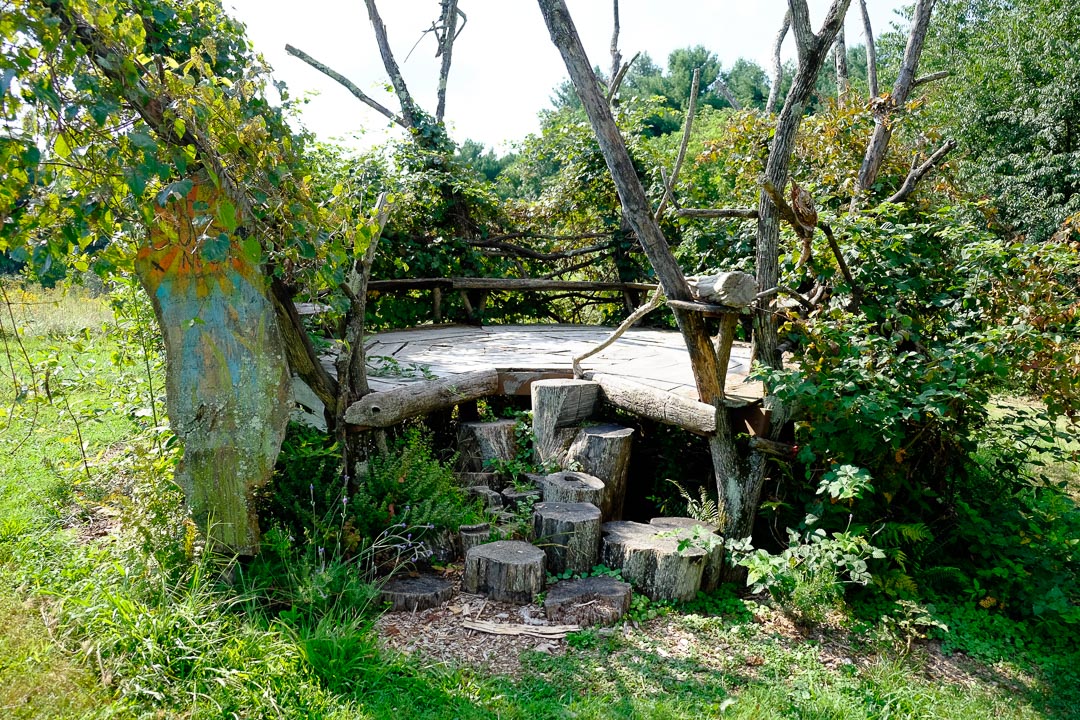Sign on roadside barn near Duck Run Natural Cemetery. photo by Tom Bailey
Americans believe in the perpetuity of their graves. Yet cemeteries don't sell plots of land, they sell burial rights. The ownership entity holds the property whether as a private for-profit or nonprofit corporation, a municipality or a religious organization. Since you don't own a plot, this means you have the right to be buried in the space in perpetuity--technically forever. The cemetery can't do anything else with the space, like bury someone new in it. In conventional cemeteries with embalmed bodies in long-lasting hydro-sealed caskets protected by concrete vaults perpetual rights make a certain sense. But for natural burial, which is about getting out of the way of the agents that would turn a human body back to the soil, isn't perpetuity a bit silly?
Granted the most difficult thing to overcome might be Americans' knee-jerk reaction to the idea of disturbing graves, but I decided to look at what is done elsewhere, and what may be underway in this country to change the equation.
The idea of perpetual grave rights originated here and became prevalent as burial moved out of communal churchyards and town burial grounds to cemeteries which sold plots to a general public. In much of the rest of the world, contracts for burial space are more like leases. When a lease is up, in some places you can renew it, in others your exclusive right to the plot ends and the ground can be reused. Remains (bones mostly) are either removed from the grave and placed in an ossuary or the grave dug deeper so that it can hold the bones at the bottom and a new burial above. Grave leases that include the right to erect a memorial will specify what happens to the memorial at the end.
Perpetual care marker at Forest Hill Cemetery, Madison, WI. Photo by Claire S. Bjork
Judging by our predilection for permanence in burial the renewable burial plot is on the cutting edge of afterdeath care options. However, two green burial cemeteries in the US and one in Canada offer graves that can be reused. I was curious what prompted them to go against the grain (out of roughly 135 cemeteries which I surveyed).
For two of them sustainable use of land is the primary reasons for not opting simply for perpetuity. Their arguments are especially poignant in light of one of green burial's most difficult issues: the fact that burial takes up so much space. This is the one argument that less-environmentally sound cremation has over it.
Mountain View Cemetery is a 106-acre historic urban cemetery in the heart of Vancouver, British Columbia with Glen Hodges as cemetery manager. "Mountain View is quite unique in that we have been practicing 'sustainable' interment for more than 100 years. Since shortly after establishing the cemetery in 1886, we have always allowed families to re-use existing burial space. With the family's permission we reopen an existing grave, remove the human remains, deepen the grave, place what is left of the human remains back in the bottom, cover it with a couple inches of soil and the site is then used for another casket interment. Of the 85 casket burials we do in an average year now, probably one-third involve some kind of re-use and a 3rd or 4th casket being interred in an existing grave."
Glenn Jennelle is general manager of Duck Run Natural Cemetery in Penn Laird, Virginia, which offers what it calls "renewable" lots.
"Renewable lots are used in the UK and it works out well for them. They rotate on a 50 year basis. Think of the land that is saved by this way of burial. In setting up our own renewable options our owner and I thought 75 years would be more appropriate. If anything remains in the grave, mainly bone fragments, they would be left alone and then, our hopes are maybe a grandchild or great grandchild would want to be buried in the space. We have two folks interred this way and a few more renewable lots sold. It's something new and it takes time. We furnish headstones at no charge for this type of burial, and after 75 years they will be placed in the memorial walkways near the grave site."
But from Hunter Mohring came an explanation that aligns renewable grave use with the part of green burial that most resonates with me--recycling the human body back into the soil. Hunter is administrative steward of The Meadow, a nature preserve and natural burial cemetery in the southern portion of the Valley of Virginia nestled between the Blue Ridge Mountains and the Allegheny Spine. The Meadow offers what it calls "successive sites." Hunter has sold over half of The Meadow plots as "successive" rather than perpetual. Reuse is the most natural thing to do yet as old as that idea is, it's too "new" in our current culture so The Meadow offers both successive and perpetual graves.
What Hunter likes about the idea is that it is completely and directly aligned with the ideals of both "natural" and "sustainable." "When one's primary reason for using natural burial is to honor and participate in Earth's life cycles and contribute to the sustainability of all life, it seems counter-intuitive to lock in one use by one person forever, thereby petrifying and/or preventing the natural life-impetus embedded in the 32 square feet of land and the environment around it. All life depends on soil and all soil requires lots of dead organic material; one might think of soil as constantly hungry and thirsty. If it's not supplied with its needs, it can't play it's part in the nurturing of new seeds, new plants, new wildlife."
From a financial point of view, says Hunter, if the cemetery were to ever approach full and every grave was perpetual, the life cycle of The Meadow's 5 acres would stagnate. With no room for new burials any reason to operate the cemetery and all income for its maintenance would be removed. Typical operating procedures render a cemetery unsustainable.
Will these few cemeteries be the start of a trend? Who knows. I hope so. Modern green burial is still a new concept and while its precepts and intentions are set, the way to get there isn't fixed which means there's room for tweaking. I feel we have to address the issue of perpetual grave use or risk being called too timid to do the best thing. Calling for cemeteries to offer renewable plots won't be enough if we don't also change our attitudes toward grave rights.
"Fifty years may seem short for rotating graves, but it is enough to allow the 'natural thing' to happen to a body and then free life to do its next natural thing," says Hunter. "Seems right and fair to me."















